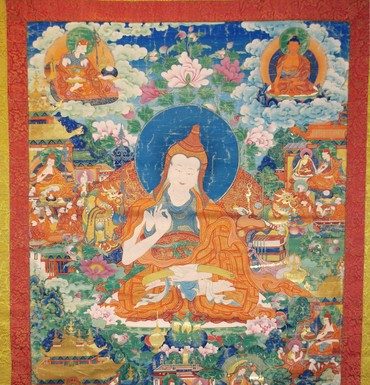Stages of the Path (lamrim) 1991-1994

In the early eleventh century the Indian Buddhist master Atisha condensed essential points from the sutras and ordered them into the text Lamp of the Path. These were then expanded upon in the fourteenth century by the Tibetan Buddhist master Lama Tsongkhapa into the text The Great Exposition on the Gradual Path to Enlightenment (Lamrim Chenmo). Venerable Thubten Chodron taught on this text over several years at Dharma Friendship Foundation, and related these practical teachings to our daily lives.
These teachings can be found in the Lamrim Teachings 1991-1994 (LR) sub-category and in the Gradual Path to Enlightenment (Lamrim) Teachings (1991-1994) series. The list below is a searchable and easy-to-navigate index of the teachings in the series.
The transcripts of these teachings have been lightly edited, organized, and formatted into ebook formats, and can be found on the books for free distribution page.
Lamrim outlines
- Overview
- Introduction
- Preparatory practices
- Foundations of the path
- Practices in common with the initial level practitioner
- Practices in common with the intermediate level practitioner
- Practices of the advanced level practitioner
- Meditation outline
- Entire outline as a PDF
Introduction to the lamrim
- Introduction to the lamrim teachings (LR001)
- How teachings should be studied and taught (LR002)
- Basic Buddhist topics (LR003)
The six preparatory practices
- Part 1 of 3: Preparing the meditation space and making offerings (LR004)
- Part 2 of 3: Obtaining offerings properly and setting the right posture (LR005)
- Part 3 of 3: Visualizing the merit field and offering the seven-limb prayer (LR006)
- What is to be done in between sessions (LR007)
Relying on a spiritual mentor
- Part 1 of 4: Advantages of relying on a teacher (LR008)
- Part 2 of 4: Disadvantages of improper reliance (LR009)
- Part 3 of 4: Relying on teachers in thought (LR010)
- Part 4 of 4: Relying on teachers in thought and deed (LR011)
Precious human life
- Part 1 of 4: The freedoms of a precious human life (LR012)
- Part 2 of 4: The fortunes of a precious human life (LR013)
- Part 3 of 4: Obtaining a precious human life (LR014)
- Part 4 of 4: Cultivating our motivation (LR015)
The path in common with the initial level practitioner
Impermanence and death
- Disadvantages of not thinking of death (LR016)
- Detaching from the eight worldly concerns (LR017)
- Meditation on death (LR018)
- Meditations on impermanence and death (LR019)
- The lower realms (LR020)
Taking refuge
- Part 1 of 10: Objects of refuge (LR021)
- Part 2 of 10: Qualities of a Buddha (LR022)
- Part 3 of 10: A Buddha’s body and speech (LR023)
- Part 4 of 10: Qualities of a Buddha’s mind (LR024)
- Part 5 of 10: Qualities of the Three Jewels (LR025)
- Part 6 of 10: Spiritual practice transforms us (LR026)
- Part 7 was not recorded
- Part 8 of 10: Benefits of having taken refuge (LR027)
- Part 9 of 10: The practice of refuge (LR028)
- Part 10 of 10: Activities after taking refuge (LR029)
Developing conviction in karma and its effects
- General characteristics of karma (LR030)
- The ten destructive actions
- Part 1 of 6: The three physical destructive actions (LR031)
- Part 2 of 6: The destructive actions of speech (LR032)
- Part 3 of 6: Three destructive actions of mind (LR033)
- Part 4 of 6: A broader view of destructive actions (LR034)
- Part 5 of 6: The results of the 10 destructive actions (LR035)
- Part 6 of 6: Meditating on the 10 destructive actions (LR036)
- Positive actions and their results (LR037)
- Classifications of karma (LR038)
- Environmental results of positive actions (LR039)
- Other ways of differentiating actions
- Part 1 of 2: Motivation and karma (LR040)
- Part 2 of 2: Various ways of describing karma (LR041)
- Favorable qualities for Dharma practice (LR042)
- Practice virtue, avoid non-virtue (LR043)
- The four opponent powers (LR044)
The path in common with the intermediate level practitioner
Contemplating the four noble truths
- The first noble truth: Dukkha (LR045)
- Eight unsatisfactory experiences of humans
- Part 1: Our unsatisfactory experiences (LR046)
- Part 2: The dukkha of cyclic existence (LR047)
- The root afflictions
- Part 1a of 5: Unsatisfactoriness of god realms (LR048)
- Part 1b of 5: Attachment and anger (LR048)
- Part 2 of 5: Pride and ignorance (LR049)
- Part 3 of 5: Ignorance, doubt, and afflicted views (LR050)
- Part 4 of 5: Afflicted views (LR051)
- Part 5 of 5: The cause of unsatisfactory experience (LR052)
- The secondary afflictions
- Part 1 of 2: The cause of unsatisfactory experience (LR052)
- Part 1 of 2: Recognizing our afflictions (LR053)
- Order of development of the afflictions and causes of the afflictions
- Part 1 of 3: The order in which afflictions develop (LR054)
- Part 2 of 3: Causes of the afflictions (LR055)
- Part 3 of 3: Inappropriate attention (LR056)
- Disadvantages of the afflictions (LR057)
- The way of leaving the body in death and taking rebirth
- Part 1 of 2: Death and the bardo (LR058)
- Part 2 of 2: The bardo and taking rebirth (LR059)
- The death and rebirth process (LR060)
- Twelve links of dependent arising (long version)
- Part 1 of 5: The wheel of life (LR061)
- Part 2 of 5: The 12 links of dependent arising: Overview (LR062)
- Part 3 of 5: Dependent arising: Links 1-3 (LR063)
- Part 4 of 5: Dependent arising: Links 4-12 (LR064)
- Part 5 of 5: The 12 links and the four noble truths (LR065)
- Becoming convinced of nature of the path to liberation
- Part 1 of 2: Path to liberation (LR066)
- Part 2 of 2: Freeing ourselves from samsara (LR067)
The path of the advanced level practitioner
The seed of enlightenment (bodhicitta)
- Advantages of bodhicitta
- Part 1 of 3: The altruistic intention (LR068)
- Part 2 was not recorded
- Part 3 of 3: Bodhicitta: Advantages and prerequisites (LR069)
- Cultivating bodhicitta through the seven points of cause and effect
- Part 1 of 4: The kindness of our mothers (LR070)
- Part 2 of 4: Repaying the kindness of our mother (LR071)
- Part 3 of 4: Generating love and compassion (LR072)
- Part 4 of 4: Generating bodhicitta (LR073)
- Cultivating bodhicitta through equalizing and exchanging self and others
- Equalizing and exchanging self and other (LR074)
- Part 1 of 3: Equalizing self and other (LR075)
- Part 2 of 3: Disadvantages of self-centeredness (LR076)
- Part 3 of 3: Advantages of cherishing others (LR077)
The bodhisattva ethical restraints
- Commitments of aspiring bodhicitta (LR078)
- How the bodhisattva vows are useful (LR079)
- Eighteen root vows
- Root bodhisattva vows: Vows 1 to 4 (LR080)
- Root bodhisattva vows: Vows 5 to 13 (LR081)
- Root bodhisattva vows: Vows 14 to 18 (LR082)
- 46 auxiliary vows
- Auxiliary bodhisattva vows: Vows 1-5 (LR083)
- Auxiliary bodhisattva vows: Vows 6-12 (LR084)
- Auxiliary bodhisattva vows: Vows 13-16 (LR085)
- Auxiliary bodhisattva vows: Vow 22 (LR086)
- Auxiliary bodhisattva vows: Vow 23-30 (LR087)
- Auxiliary bodhisattva vows: Vow 30-36 (LR088)
- Auxiliary bodhisattva vows: Vow 35-40 (LR089)
- Auxiliary bodhisattva vows: Vow 39-46 (LR090)
The six far-reaching practices
- The six far-reaching attitudes (LR091)
- The far-reaching practice of generosity
- Part 1 of 2: The three forms of generosity (LR092)
- Part 2 of 2: Generosity according to the four points (LR093)
- The far-reaching practice of ethics
- Part 1 of 2: Far-reaching attitude of ethics (LR094)
- Part 2 of 2: Ethics and the other perfections (LR095)
- The far-reaching practice of fortitude
- Part 1 of 4: Disadvantages of anger (LR096)
- Part 2 of 4: Anger and its antidotes (LR097)
- Part 3 of 4: The patience of not retaliating (LR098)
- Part 4 of 4: The far-reaching practice of patience (LR099)
- The far-reaching practice of joyous effort
- Part 1 of 5: Far-reaching joyous effort (LR100)
- Part 2 of 5: The three types of laziness (LR101)
- Part 3 of 5: Overcoming discouragement (LR102)
- Part 4 of 5: The four aspects of joyous effort (LR103)
- Part 5 of 5: Cultivating joy and rest (LR104)
- The far-reaching practices of meditative stabilization and wisdom (in brief)
- Part 1 of 2: Complementary nature of the perfections (LR105)
- Part 2 of 2: Perfections of concentration and wisdom (LR106)
- The far-reaching practices of meditative stabilization
- Part 1 of 9: Training in calm abiding (LR107)
- Part 2 of 9: Preparing for calm abiding meditation (LR108)
- Part 3 of 9: Objects of meditation (LR109)
- Part 4 of 9: Objects of meditation and deterrents (LR110)
- Part 5 of 9: Forgetting the object of meditation (LR111)
- Part 6 of 9: Calm abiding review (LR112)
- Part 7 of 9: Laxity and excitement (LR113)
- Part 8 of 9: Excitement and application (LR114)
- Part 9 of 9: Developing calm abiding (LR115)
- The far-reaching practice of wisdom
- Part 1 of 2: Three levels of dependent arising (LR116)
- Part 2 of 2: Establishing selflessness (LR117)
- Training in the four factors ripening the minds of others
- Part 1 of 2: Ripening the minds of others (LR118)
- Part 2 of 2: The four factors of gathering disciples (LR118)
The eightfold noble path
- Part 1 of 5: Eightfold noble path (LR119)
- Part 2 of 5: Right action and livelihood (LR120)
- Part 3 of 5: Right mindfulness (LR121)
- Part 4 of 5: Right concentration and effort (LR122)
- Part 5 of 5: Right effort, view, and thought (LR123)
- The eightfold path: Benefitting others (LR124)
Venerable Thubten Chodron
Venerable Chodron emphasizes the practical application of Buddha’s teachings in our daily lives and is especially skilled at explaining them in ways easily understood and practiced by Westerners. She is well known for her warm, humorous, and lucid teachings. She was ordained as a Buddhist nun in 1977 by Kyabje Ling Rinpoche in Dharamsala, India, and in 1986 she received bhikshuni (full) ordination in Taiwan. Read her full bio.

